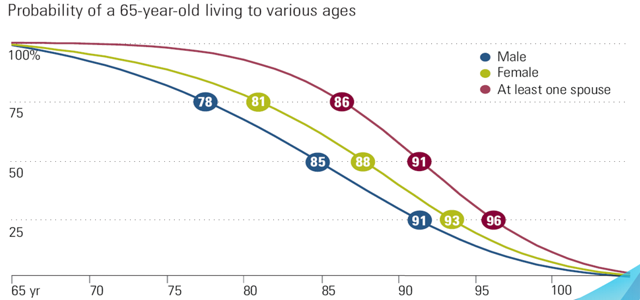
Even without Vulcan genes, many of us are living longer. Japanese Jiroemon Kimura‘s nearly 116 years, making him the oldest man in modern recorded history, is a reminder to have a retirement income plan that will last over the long haul.
Kimura was born in 1897, the same year that inventor Thomas Edison patented his movie camera and Queen Victoria held the British crown. It’s been 51 years since Kimura retired from the post office in 1962.
To put this 51-year retirement time horizon in perspective, consider that those who begin their career at age 22 will likely work less than 45 years. As people live longer, it will become commonplace to see them spend more years in retirement than they did on the job. Let me repeat this surprising effect of health care innovation: Many will join Jiroemon Kimura in seeing their retirement years outlast their career and this will require a bundle of savings.
The first challenge for retirees is to determine how many years to include when testing a financial plan. Life expectancy tables suggest that a 65-year-old man will live between 78 and 87 years depending on which data sets you use and whether he smoke or not. Women, who still soundly hold the record for longest recorded life at 122, can add an additional two years to this range. However, using life expectancy as your planning age will fail the half of retirees who live beyond their actuarial life expectancy.
No one wants to live with a 50% success rate, which is why financial advisers suggest using older ages for planning. The Annuity 2000 Mortality Table suggests there is a 25% chance that one spouse of a couple who are both age 65 will live to age 96 and a 10% chance that one of the two will live to age 101. Our firm typically uses age 100 for planning purposes. Of course, very few people live to be centenarians, but everyone is better safe than sorry.

Using a longer planning age means that retirees will need to stretch their dollars longer and take out less from retirement accounts. We estimate that retirees with a 20-year planning horizon can safely distribute 6.45% of their after-tax portfolio without running out of resources. A 40-year planning horizon pulls that safe withdrawal rate back to 4.11%. For a $1 million portfolio, this change in assumptions is the difference between an annual income of $64,500 and $41,100 in retirement.
Those who neglect to save and rely on an employer pension are in for a rude awakening. Most corporate pensions are using unrealistic investment growth expectations to paint over their underfunded status. As retirees live longer, employers need to be prepared for future battles with current workers over how to correct these funding gaps. Benefits for retirees are sure to be on the chopping block.
Social Security is also unlikely to maintain benefits as life expectancies increase. In fact, I find it ridiculous that in the 80 years since the founding of Social Security in 1933, the full retirement age that qualifies for full benefits has only increased by one year from age 65 to age 66 today.
Denmark and France now adjust the number of years required to get a full benefit and link this to life expectancy. Finland and Germany use longevity data to adjust the benefit amounts. Like a permanent AMT patch, we should legislate some type of more fluid system so that intuitive and necessary adjustments do not invoke a political war with the AARP lobby over every small change.
Instead of addressing the issues of longevity directly, our politicians are playing games with Social Security benefit calculations. As part of the recent budget negotiations, several members of Congress have called for a reduction in the inflation calculation. A new cost-of-living measure, using what is called the chained consumer price index (CPI), is being proposed. Chained CPI grows slower than the current calculation (CPI-W), the standard index for wage earners. This new gauge ignores the reality that inflation is already underreported for retirees. For example, the monthly cost of retirement communities increases twice as fast as CPI-W suggests.
There is no substitute for taking personal responsibility to save for a long retirement. Some may plan to work forever, but the reality is that many people run into health problems along the way and are forced to retire.
Jiroemon Kimura has some additional advice for those who wish to pursue his path to healthy longevity: “Eat smaller portions.” I believe Kimura’s sage advice applies beyond the dinner plate. Learning to live on less and save more is a good new year’s resolution for people of all ages.
Live long and prosper!